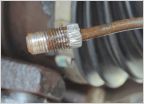-
Welcome to Tundras.com!
You are currently viewing as a guest! To get full-access, you need to register for a FREE account.
As a registered member, you’ll be able to:- Participate in all Tundra discussion topics
- Transfer over your build thread from a different forum to this one
- Communicate privately with other Tundra owners from around the world
- Post your own photos in our Members Gallery
- Access all special features of the site
Green Brake Fluid?
Discussion in '1st Gen Tundras (2000-2006)' started by GuiltySpark, Nov 25, 2024.


 Stripped inverted flare nut on caliper
Stripped inverted flare nut on caliper 06AC cargo/brake light housing gasket advice/comment
06AC cargo/brake light housing gasket advice/comment New Tundra! And a SW control question
New Tundra! And a SW control question Rear Bumper
Rear Bumper Impact Gun Recommendations
Impact Gun Recommendations














































































